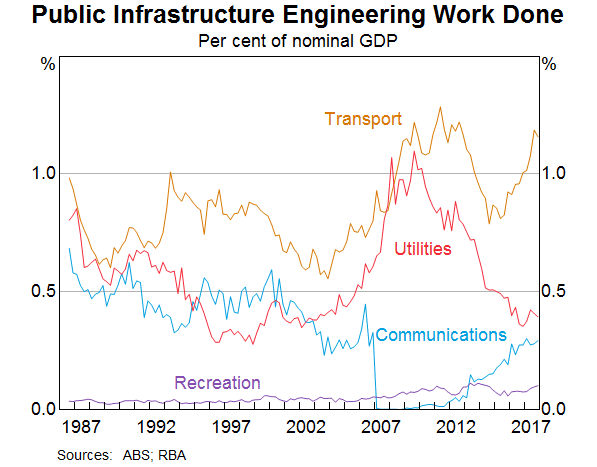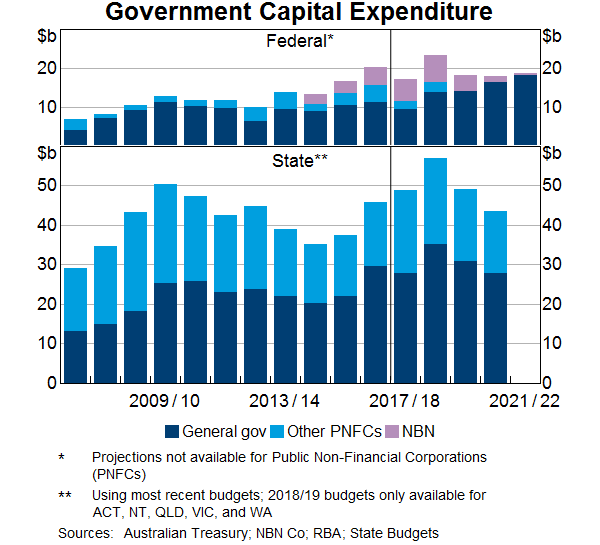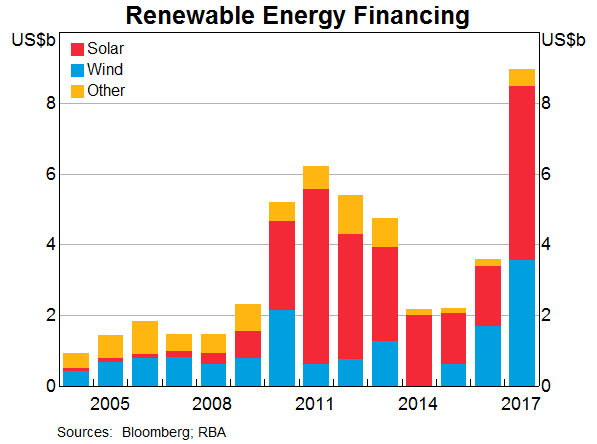Speech How Infrastructure Fits In

Luci Ellis[*]
Assistant Governor (Economic)
Speech at the Infrastructure Partnerships Australia (IPA) Leaders' Luncheon
Sydney –
I'm grateful for the opportunity to speak to you today, and conscious of the infrastructure expertise in the room. There wouldn't be anything I could add to what you know about project design, selection or funding. What I would like to do today is place infrastructure in a broader context. Specifically, I plan to talk about the role of infrastructure from the perspective of someone involved in macroeconomic policy: the policy challenges and opportunities, the work of the G20 and role of infrastructure as not just an engine of growth but, more importantly, an enabler of growth.
What Is Infrastructure?
Before getting into that, it's useful to define what we are talking about. When macroeconomists think about infrastructure, we think about the capital goods that provide public services. They are shared facilities that help economies function well. These include the structures – that is, the things produced by the construction industry that, unlike buildings, don't have roofs. But there are also many other shared facilities that promote a well-functioning economy and society. One example of those other important pieces of infrastructure is the New Payments Platform that was launched recently. There are also important social infrastructures such as our legal system, or our frameworks for safeguarding children. But for the purposes of my talk, I will focus on the things that are tangible.
Within this class of tangible physical infrastructure, we can think of various kinds of physical assets. There is transport infrastructure, utilities providing electricity, gas and water, and communications infrastructure. Within each of these groups there are ‘hubs’ or centres, such as airports and railway stations for transport, power stations and reservoirs providing utilities, or telephone exchanges and satellites facilitating communication. Also within each group are ‘paths’ or distribution networks, such as the road and rail networks, power lines and telecommunications networks.
As you all well know, infrastructure of this kind can be provided by either the private or public sectors. The public sector might be involved for a number of reasons. One is that it is generally accepted that there are social benefits to providing these kinds of assets that are not fully captured by a profit-making provider. Without some provision by the state, such infrastructure will be under-provided. Another is the network nature of these facilities. Where there is a network, there is an element of monopoly power, and thus often a role for state regulation if not actually state ownership. At the very least, someone needs to set the rules of the game, whether that is the side of the road we drive on or the protocols used in telecommunications.[1]
Despite the role of the state in the provision and management of these types of infrastructure, they are not ‘public goods’ in the textbook sense. Textbook public goods are non-rival and non-excludable: their benefits aren't diminished by an extra person enjoying them and, in any case, you can't prevent people from having those benefits. Clean air and a defence force fall into this category. By contrast, physical infrastructure can clearly suffer from congestion. It is also conceptually possible to exclude free riders from the use of the infrastructure, though this is more easily achieved in some cases than others. It is from these characteristics – congestion, excludability and the underlying monopoly network – that most of the policy challenges around infrastructure arise.
What Policy Challenges Does Infrastructure Pose?
Much like any business decision faced by private firms, decisions about infrastructure involve a lot of uncertainty. Businesses grapple with these questions every day. Should we build it? Is the market big enough? Where should we build it? What design and methods should we use? What price should we set?
It is tempting to think that physical infrastructure is no different. Many of the questions are the same. But there are differences, and the policy challenges around infrastructure stem from that. Firstly, infrastructure can be very long-lived, which compounds the uncertainty about future usage rates and congestion. Secondly, the network element of the infrastructure makes it especially difficult to forecast market size. Thirdly, the social benefits that spill over to the broader economy are harder to quantify than a forecast revenue stream.
All countries face the same challenges of providing enough infrastructure in the right places to serve the needs of their populations. So it is no surprise that infrastructure has been a recurring topic in the deliberations and work of the G20 group of major economies. Australia elevated the topic further during its presidency year in 2014. This year, the Argentine presidency has also included it as one of its key priorities and has re-convened the G20 Infrastructure Working Group, which met in Sydney earlier this month.
One typical challenge is risk management. Infrastructure risk takes many forms. There's the risk that the project is not built efficiently, that investors are unwilling, that demand is too high – leading to congestion – or not high enough. There are risks that revenue can't be collected as intended. There are risks that the construction isn't resilient to natural disasters or just ordinary wear and tear.
Another typical challenge is financing. Most infrastructure assets cost a lot upfront to build, and their monetary return – if any – is only realised over a long period. This can still be an attractive payoff structure for private investors, depending on how the project is structured. Ensuring private sector participation in infrastructure finance has therefore been a priority of the G20.
A common thread in these challenges is that the nature of the risks and funding issues are very different in the ‘build phase’ than in the ‘run phase’, once the infrastructure is being used. This is true of any large construction project and, similarly, one solution can be to have different actors involved in the two stages.
What Policies Might Lessen These Challenges?
The good news is that, if we face common challenges, the solutions are also likely to be common. We can learn from each other. So there is value in sharing information about best practice across countries. For example, during Australia's G20 presidency in 2014, a Global Infrastructure Hub (GI Hub) was announced, with an aim of, among other things, sharing guidance on best practices. If you think about it, the principles for designing a good road network or locating a railway line don't really change according to where you live. There will be differences relating to legal frameworks or other national specifics, but most of what constitutes best practice will be universal.
To lessen the financing challenge, G20 authorities have been focusing on initiatives that can make infrastructure an attractive asset class.[2] There is plenty of private sector financing looking for the stable long-term cash flows that certain kinds of infrastructure assets can provide, once they are built. The question is how to bring that financing to the projects that need it, especially in emerging market economies where the need seems to be greatest. Different countries have approached this topic differently (Chong and Poole 2013). The report ‘Roadmap to infrastructure as an asset class’,[3] which G20 Finance Ministers and Governors endorsed in March, proposed several initiatives that should help, including to:
- enhance project preparation so that projects are more ‘bankable’
- align the risk of projects to the risk profile of investors
- increase the data available on projects
- promote quality infrastructure and good governance
- improve local currency capital markets in emerging markets
- explore the creation of standardised contracts for activities such as financing and risk sharing.
Some of these initiatives can work as collaborative efforts with the private sector. Others, such as aligning risks, may require more effective use of credit enhancement from the public sector or from supranational agencies, such as the multilateral development banks (MDBs). This is seen as a way of ‘crowding in’ private finance rather than have the MDBs fund the project themselves.
Here's where the Australian experience might be instructive. As a central banker, I can look around the world and see that most countries have settled on the idea of having a specialist, independent agency to carry out the kinds of responsibilities that central banks usually have, such as setting monetary policy or running the payments system. The same is true for many kinds of financial regulation. It is less common to have an autonomous agency involved in analysing and assessing microeconomic policy. But in Australia, we do have something like that in the Productivity Commission. And similarly we have an independent statutory authority for assessing and prioritising infrastructure projects, Infrastructure Australia.
As a non-specialist it is not possible for me to quantify what difference this makes. But if common frameworks and rigorous, pre-emptive analysis help – and I believe they do – then Australia's experience will surely be instructive for other economies wanting to improve their infrastructure.
What Is the Current State of Play in Australia?
In comparison to some countries, international research suggests that Australia is fairly well served by its current infrastructure.[4] But with a strongly growing population, we face a challenge of ensuring that the stock of infrastructure keeps pace with expanding needs. Utilities such as electricity and water, as well as transport links, need ongoing investment to accommodate a rising population.
This challenge has clearly been recognised and, over recent years, governments at both the state and federal level have been increasing infrastructure investment. As can be seen from this graph, public investment in communications infrastructure has increased with the rollout of the NBN. Transport infrastructure – road and rail – has increased even more sharply and is back close to the share of GDP it represented in the years immediately after the global financial crisis.

The recent federal budget foreshadowed additional infrastructure spending. More broadly, investment by the federal government is projected to increase over coming years. Most of the infrastructure spend is by state governments, however. This has already increased noticeably, particularly in the south-eastern states, and according to state budgets it is projected to increase further in the next couple of years. Much of this work is in urban transport projects, both road and rail.

Another area of infrastructure attracting substantial investment at the moment is renewable energy. The value of renewable generation projects slated for the next year or so is similar to the average of recent years' total investment in electricity generation, distribution and transmission, a much broader set of activities. Most of the investment in renewables is by the private sector. These projects have become more attractive lately as the cost of the underlying technology has fallen. At the same time, the costs of fossil-based inputs to existing generation methods has risen, and so has the price of electricity. So renewable energy projects are becoming increasingly commercially viable. As such, it is an area where the private sector can provide the infrastructure.
And that is indeed what we are seeing. A range of data sources on both capital expenditure and financing show greatly increased activity recently (Graph 3). A few years ago, much of the investment in renewables was in small-scale rooftop solar. More recently, as the economics of these projects has changed, we are seeing more large-scale solar and wind projects being financed and built.

As I mentioned earlier, the risks and challenges of the build phase are very different from those in the run phase. There will be some areas, like renewables, where the private sector will be involved in both phases. In others, the execution and governance risks in the build phase don't match investors' desired risk profiles, but the revenue from the operation phase can do so. These kinds of projects will be good candidates for private ownership once construction is complete; some state governments are recycling the revenue from those sales to fund new infrastructure. And finally, there are projects where the social benefits are not easily captured as cash flow. It is important that these kinds of projects are not under-provided, just because they would not be profitable for the private sector to run.
Regardless of the exact approach to funding and management of construction, infrastructure investment can involve significant spillover benefits to the rest of the economy. The Bank has discussed these recently, and they bear repeating (RBA 2018). The direct spillovers derive from the incomes earned by the workers and firms doing the work; most of these projects are built by the private sector on behalf of the public sector. This income gets spent or invested, which in turn generates income for someone else and so on. At a time such as now, when there is still spare capacity in the economy, this ‘fiscal multiplier’ can result in overall demand rising by considerably more than the original spend on the project.
More broadly, and over a longer horizon, the economy benefits from a larger capital stock and the productivity benefits of infrastructure of this type. These are often hard to quantify even after the fact, but some examples might include: new export businesses enabled by the construction or expansion of an airport; higher productivity of logistics firms if their vehicles spend less time in traffic; and better health outcomes from reduced accident rates when roads are made safer.
It is these benefits that are worth focusing on, more than the raw contribution of the building work to GDP growth. As I've emphasised on an earlier occasion, it isn't helpful to think of infrastructure as a new ‘engine of growth’, receiving the handover from the mining investment boom and, later, the apartment building boom (Ellis 2017). By its nature, infrastructure is justified by its contribution to the public good. It is not so much an engine of growth as an enabler of growth. But for this to be true, projects need to be rigorously assessed, carefully designed and appropriately timed. And for that to be possible, it helps if practitioners can learn from each other, for example through forums such as this one and, internationally, the initiatives of the G20.
Thank you for your time.
Endnotes
Thanks to Ashwin Clarke, Rachel Adeney and Tomas Cokis for assistance with elements of this talk. [*]
Some important economic infrastructure, like the internet, has been able to expand and develop via cooperative governance and standard-setting by industry bodies with voluntary membership. But the role of public telecommunications networks and government-funded universities and other bodies in these areas should not be ignored. [1]
The Australian Treasury co-chairs the group designing and implementing these initiatives. [2]
See Group of Twenty (2018). [3]
See McKinsey Global Institute (2016). [4]
Bibliography
Chong S and E Poole (2013), ‘Financing Infrastructure: A Spectrum of Country Approaches’, RBA Bulletin, September, pp 65–76.
Ellis L (2017), ‘Where is the Growth Going to Come From?’, Stan Kelly Lecture, University of Melbourne, Melbourne, 15 November.
Group of Twenty (2018), ‘Roadmap to Infrastructure as an Asset Class’, Report to the G20 Ministers and Governors. Available at <https://www.g20.org/sites/default/files/documentos_producidos/roadmap_to_infrastructure_as_an_asset_class_argentina_presidency_0.pdf>.
McKinsey Global Institute (2016), ‘Bridging Global Infrastructure Gaps’, June. Available at <https://www.mckinsey.com/~/media/McKinsey/Industries/Capital%20Projects%20and%20Infrastructure/Our%20Insights/Bridging%20global%20infrastructure%20gaps/Bridging-Global-Infrastructure-Gaps-Full-report-June-2016.ashx>.
RBA (2018), ‘Box C: Spillovers from Public Investment’, Statement on Monetary Policy, February, pp 40–42.